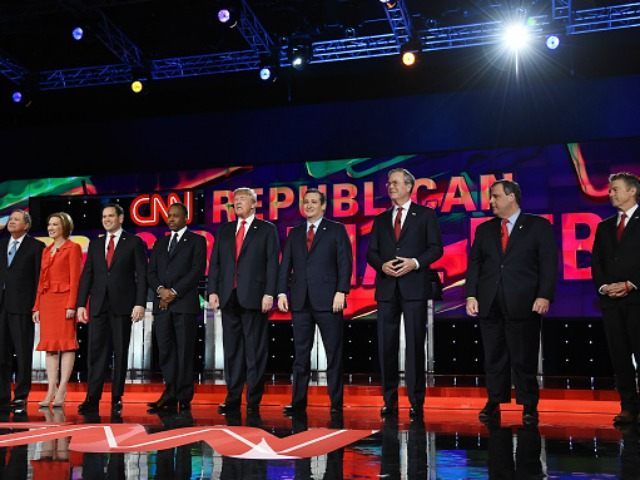Former Florida Gov. Jeb Bush and Florida Senator Marco Rubio share a complicated political history, with Rubio a one-time protegé of Bush the younger. In the 2016 presidential race they share another distinction as the two candidates most dominating the airwaves with paid political ads.
Jeb Bush has spent a massive $35 million on paid advertising so far this campaign, with $17 million spent in New Hampshire and $9 million devoted to Iowa. The money has come from both his individual campaign and the Right to Rise super pac allied with his candidacy.
In spite of this ad buy, Bush earns just four percent support nationally in the RealClearPolitics average of polls. In New Hampshire, where his ads dominate the airwaves, Bush is in 5th place with just seven percent of the vote. Bush is also 5th in Iowa, with just 5.6 percent support. In a recent Des Moines Register poll, however, a strong majority of Republican voters have an unfavorable view of Bush.
The stunning failure of Bush’s ad spending to reverse his poll slide, though, obscures the fact that other candidates have spent large sums on advertising to little effect.
Marco Rubio is second to Bush among all candidates for paid advertising. His campaign and two allied super pacs have spent over $15 million on advertising. Rubio has even spent $4 million more than Hillary Clinton on campaign advertising.
While Rubio has obviously fared much better in polling than Bush, his standing is not commensurate with his ad spending, looking at past campaigns. In national polls, Rubio is currently tied with Ben Carson for third. Rubio’s ad spending is more than six times the amount Carson has spent, however.
Rubio’s relative position in state polls fluctuates, but his share of the vote remains at around 10-12 percent support. Given the amount of ad spending by his campaign and general praise from most political pundits, Rubio ought to be doing better at securing Republican votes.
The complication for Rubio, it seems, is that the voters he is targeting are also being bombarded with ads from candidates with a similar pro-establishment viewpoint. Ohio Gov. John Kasich, unbelievably, has spent over $8 million on paid advertising. New Jersey Gov. Chris Christie has spent about $8 million on ads.
Even long-shot candidate, South Carolina Sen. Lindsey Graham, has spent almost $3 million on paid advertising, mostly in New Hampshire. He currently commands just 0.3 percent support among Republicans in the Granite State.
Christie and Kasich also have focused their ad spending on New Hampshire, although to slightly better effect. Christie currently earns 10 percent support in the first primary state, while Kasich has seven percent support. One could easily imagine these supporters moving to Rubio if Christie and Kasich weren’t in the race. Their ad buys, however, suggest they are in the campaign at least until New Hampshire votes next February.
Interestingly, the candidates that have spent the least on paid advertising are currently leading the Republican polls. Donald Trump, who is his own phenomenon, has spent just $217,000 on paid advertising. Texas Sen. Ted Cruz, who has recently been rising rapidly in polling, has spent just $1.2 million. Cruz’s spending is about the same as that spent by Kentucky Sen. Rand Paul and businesswoman Carly Fiorina.
Together, Trump and Cruz have support from a majority of Republicans nationally, and in many individual states. Yet, together, they have spent just $1.5 million on advertising, about a tenth of what Rubio has spent. Bush has outspent the two frontrunners by 30-1.
There are perhaps many lessons to draw from these spending numbers and polling support. One lesson is clear, paid advertising is rapidly declining as an effective campaign tactic. As recently as the last presidential election, overall spending on advertising was a decent proxy for how a candidate would perform in polls.
This is perhaps the greatest challenge to the political establishment posed by candidates like Trump, Cruz, and Carson. The entire political establishment, of both parties, is fueled by rich commissions earned off paid advertising buys. The commissions are so large, in fact, that campaign consultants regularly push campaigns to devote an enormous share of their campaign budgets to advertising.
The simple fact that Sen. Lindsey Graham, who doesn’t even really register in national or state polls, has spent almost $3 million on advertising is the prime example of this phenomenon. That data point alone ought to call into question Graham’s grasp of any kind of fiscal prudence.
The entire infrastructure of the Republican party is built, largely, on huge fees from paid advertising. Bush and Rubio, naturally, are fully devoted to this system, as are Kasich, Christie, and Graham. Together, these candidates have spent over $60 million on paid advertising, earning collectively less than 20 percent of the Republican vote nationally.
Just three candidates, Trump, Cruz, and Carson together have more than 60 percent support from Republicans across the country. They, however, have spent less than $5 million on advertising.
The Republican party’s addiction to paid advertising may be its ultimate undoing.

COMMENTS
Please let us know if you're having issues with commenting.